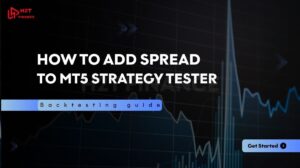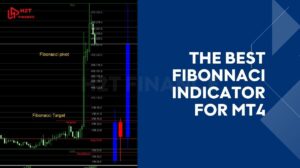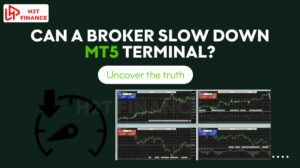Picture this: your trade is showing an impressive floating profit. It's a great feeling, but deep down, a crucial question that every trader has asked begins to surface: is margin still used when in floating profit?
This confusion is common, but understanding it clearly is the key to protecting your capital and making smarter trading decisions. Floating profit does empower your account, just not in the way you might think. Let’s dive deep to gain full control of your account.
Key takeaways:
- Margin remains locked: Margin is always held as collateral by your broker for open positions, even when trades are in floating profit, and is only released when the position is closed.
- Floating profit boosts equity: Unrealized gains increase your account’s equity, which in turn increases free margin, providing more flexibility for new trades or absorbing losses.
- Free margin is critical: Free margin (Equity - Used Margin) determines your ability to open new positions or withstand market fluctuations without triggering a margin call or stop out.
- Risk management is essential: Floating profits are not guaranteed and can turn into losses, impacting equity and margin levels. Tools like stop losses and conservative leverage are vital for protecting your account.
- Practical strategies: Increase free margin by closing unprofitable trades, reducing position sizes, depositing funds, locking in profits, or optimizing leverage to maintain account flexibility and safety.
1. What is margin in Forex trading?
Margin is a cornerstone of Forex trading, enabling traders to control large positions with a fraction of the capital. But what exactly is it, and why does it matter when you’re in floating profit? This section breaks down the concept of margin and its role in your trading account, setting the stage for understanding its interaction with floating profits.
1.1. What margin is and how it works
Margin in Forex is the amount of money your broker requires as collateral to open and maintain a trading position. Think of it as a deposit that allows you to leverage your capital, controlling larger trades than your account balance would permit.

For example, with a 4% margin requirement, a $10,000 position requires $400 of margin. This “used margin” is locked until the position is closed. Margin is essential for leveraging trades, but it also introduces risks if not managed properly. Key margin-related terms include:
- Required margin: The amount needed to open a specific position.
- Used margin: The total margin locked across all open positions.
- Free margin: The difference between your account’s equity and used margin, available for new trades or to absorb losses.
1.2. Why margin matters
Margin is critical because it determines your ability to open new positions and withstand market fluctuations. When trading, your broker calculates used margin based on position size and leverage.
For instance, a 1 mini lot (10,000 units) USD/JPY trade with a 4% margin requirement locks up $400. If your account balance is $1,000, this leaves $600 as free margin. Understanding margin helps you avoid margin calls or stop outs, which can occur if your account’s equity falls too low.
2. What is Free Margin?
Free margin is a critical concept in Forex trading, representing the amount of capital available in your account for opening new positions or absorbing potential losses. Understanding free margin is essential for managing your trading account effectively, especially when dealing with floating profits or losses.
This section explains what free margin is, how it’s calculated, and why it plays a pivotal role in your trading strategy.
2.1. Definition of free margin
Free margin is the portion of your account’s equity that is not tied up in open positions. It is calculated as:
Free Margin = Equity - Used Margin
- Equity: Your account balance plus or minus any floating profit or loss from open positions.
- Used Margin: The total amount of collateral locked by your broker to maintain open positions.
For example, if your account balance is $1,000, you have a $100 floating profit, and your used margin is $400, your equity is $1,100 ($1,000 + $100), and your free margin is $1,100 - $400 = $700. This $700 is available for new trades or to cover potential losses.
2.2. Why free margin matters
Free margin is a key indicator of your account’s flexibility. A higher free margin means you have more room to open additional positions or withstand market volatility without triggering a margin call. Conversely, low free margin limits your ability to trade and increases the risk of a stop out if losses reduce your equity.
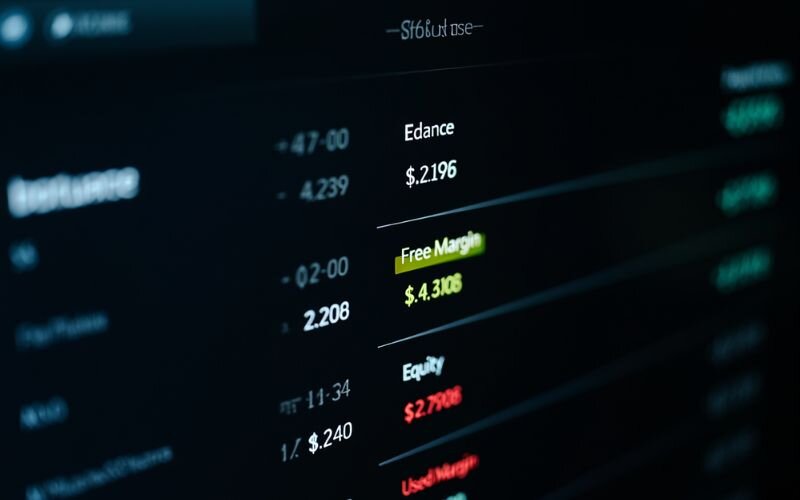
For instance, if your free margin drops to $100 due to floating losses, you may not have enough capital to open new trades or absorb further market declines. Monitoring free margin helps you make informed decisions about position sizing and risk management.
2.3. Free margin and your trading decisions
Free margin directly affects your ability to manage trades. When you have a floating profit, your equity increases, boosting free margin and allowing you to open more positions. However, if a trade turns into a floating loss, your equity and free margin decrease, potentially restricting your trading capacity.
For example, with a $1,000 account balance, $400 used margin, and a $200 floating loss, your equity drops to $800, leaving only $400 in free margin. If your broker requires a minimum margin level (e.g., 100%), a further drop in equity could trigger a margin call.
To avoid this, always keep an eye on your free margin and adjust your trading strategy accordingly.
View more:
- Raw spreads vs no commission: Which forex account is better?
- What is stop limit price in Forex? Guide for beginners
- What time frame is best for demand and supply indicator?
3. What is floating profit in Forex?
Understanding floating profit is key to grasping how your Forex trades impact your account, especially when asking, “Is margin still used when in floating profit?”
Floating profit reflects the real-time gains or losses of your open positions, influencing your account’s equity and trading decisions.
This section explains what floating profit is, how it differs from realized profit, and its effect on your trading account.
3.1. Definition of floating profit
Floating profit, also known as unrealized profit or loss (P/L), is the potential gain or loss from an open Forex position based on current market prices. It’s calculated as:
Floating P/L = (Current Price - Entry Price) x Position Size x Pip Value.
For example, if you buy 1 mini lot (10,000 units) of EUR/USD at 1.1050 and the price rises to 1.1070, your floating profit is (1.1070 - 1.1050) x 10,000 x $1 = $20 (20 pips x $1/pip). Pip value varies by currency pair, affecting P/L calculations. This profit remains “unrealized” until you close the position.
3.2. Floating profit vs. realized profit
Unlike realized profit, which is locked in when you close a trade and added to your account balance, floating profit fluctuates with market prices.
For instance, if your EUR/USD trade from above drops to 1.1030, your floating profit becomes a $20 loss (1.1030 - 1.1050 = -20 pips). Only when you close the position does the profit or loss become realized, impacting your balance. For more on this, see our article on Unrealized vs. realized P/L.
3.3. How floating profit affects your trading account
Floating profit directly impacts your account’s equity (Equity = Account Balance + Floating P/L). If you have a $1,000 balance and a $50 floating profit, your equity is $1,050. This increase can boost your free margin (Free Margin = Equity - Used Margin), giving you more room to open trades or absorb losses.
Conversely, a floating loss reduces equity, potentially limiting your trading capacity. Understanding this dynamic is crucial for managing risks, as we’ll explore next.

4. How margin and floating profit interact
A common question among Forex traders is, “Is margin still used when in floating profit?” Understanding how margin and floating profit work together is essential for effective account management.
This section answers whether margin remains locked during profitable trades, explores its impact on free margin, and explains how these dynamics affect your margin level.
4.1. Is margin still locked while in floating profit?
Here is the most direct and crucial answer: Yes, your margin is still fully used (locked up) even when your trade is in floating profit. Many traders mistakenly believe that profits will 'free up' some of this margin, but in reality, it remains held as collateral for the position until you close it.
For example, if you open a 1 mini lot (10,000 units) USD/JPY position with a 4% margin requirement, $400 is locked as used margin. Even if the trade gains a floating profit of $100, the $400 used margin stays unchanged until the position is closed.
4.2. Does floating profit free up margin?
Floating profit does not free up used margin but increases your equity and free margin. Equity is calculated as Equity = Account Balance + Floating P/L. If your account balance is $1,000, used margin is $400, and you have a $100 floating profit, your equity becomes $1,100, and free margin is $1,100 - $400 = $700.
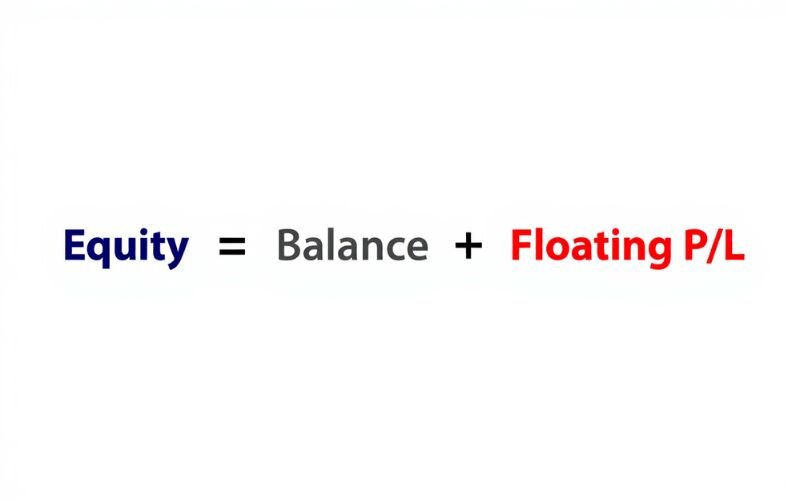
This extra free margin can be used to open new positions or absorb potential losses. Conversely, a floating loss reduces equity and free margin, as explained in our guide on What is free margin in Forex?.
4.3. Impact of floating profit on margin level and free margin
Floating profit affects your margin level, calculated as (Equity / Used Margin) x 100%. A higher floating profit boosts equity, increasing the margin level and reducing the risk of a margin call or stop out.
For example, with $1,000 equity and $400 used margin, a $200 floating profit raises equity to $1,200, making the margin level ($1,200 / $400) x 100 = 300%. However, if the trade turns into a $200 floating loss, equity drops to $800, and the margin level falls to ($800 / $400) x 100 = 200%. A margin level below your broker’s threshold (e.g., 100%) may trigger a margin call.
5. How to increase free margin in Forex
Free margin is the lifeline of your trading account, allowing you to open new positions or absorb market fluctuations without risking a margin call. Increasing your free margin is crucial for maintaining flexibility and managing risks effectively, especially when you have floating profits or losses.
This section provides practical strategies to boost your free margin while keeping your account safe and optimizing your trading opportunities.
5.1. Close unprofitable or high-risk positions
One of the quickest ways to increase free margin is to close positions that are unprofitable or consuming significant margin. Closing a losing trade or a position with high used margin frees up the collateral tied to it, instantly increasing your free margin.
For example, if you have a 1 mini lot USD/JPY position with $400 used margin and it’s showing a floating loss, closing it releases the $400 back into your free margin. Prioritize closing trades that no longer align with your strategy or have high volatility risks, such as XAU/USD during uncertain market conditions.
5.2. Reduce position sizes
Smaller position sizes require less used margin, leaving more free margin for other trades or as a buffer against losses. For instance, reducing a 1 lot trade (100,000 units) to a 0.5 lot trade halves the margin requirement, increasing your free margin.
Use a position size calculator, available on platforms like MetaTrader 4 or TradingView, to align your trades with your account balance and risk tolerance. A general rule is to keep used margin below 20% of your equity to maintain a healthy free margin buffer.
5.3. Deposit additional funds
Adding more capital to your trading account directly increases your account balance and equity, which in turn boosts free margin. For example, if your account balance is $1,000 with $400 used margin and $600 free margin, depositing an additional $500 raises your balance to $1,500 and free margin to $1,100, assuming no floating P/L.
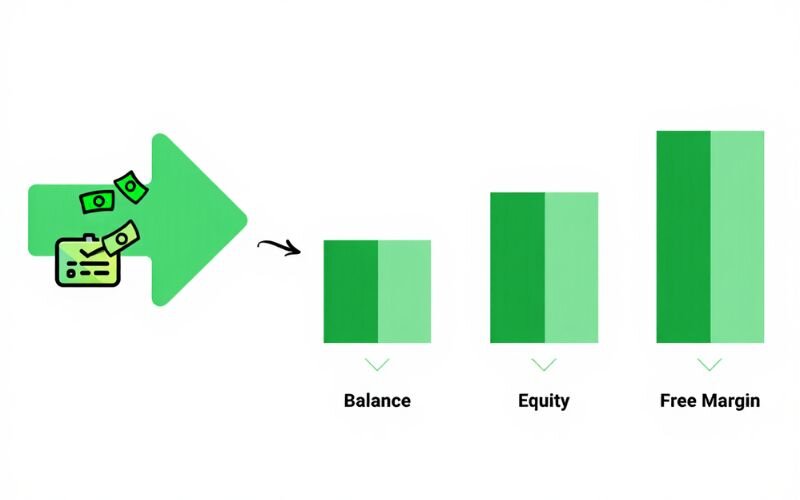
While this approach requires more capital, it can provide greater flexibility for opening new positions or weathering market volatility. Be cautious not to overfund without a clear trading plan.
5.4. Lock in floating profits
If you have a trade with a significant floating profit, consider closing it to realize the gains, which will increase your account balance and free margin. Alternatively, use a trailing stop to lock in profits while keeping the position open, protecting your equity from market reversals.
For example, a $200 floating profit on a EUR/USD trade can be secured by setting a trailing stop 10 pips below the current price. If the market reverses, the trade closes, adding the profit to your balance and boosting free margin.
5.5. Optimize leverage usage
Using lower leverage reduces the margin required for each trade, freeing up more margin for other opportunities. For instance, switching from 1:100 leverage to 1:20 on a $10,000 position reduces the required margin from $100 to $500, but it also lowers risk and preserves free margin.
Carefully assess your broker’s leverage options and choose a level that balances profitability with risk. Conservative leverage (e.g., 1:10 or 1:20) is often safer for maintaining healthy free margin levels. Check our guide on What is leverage in Forex? for more insights.
6. Risks and margin management with floating profit
While floating profits can boost your confidence, they also come with risks that can impact your margin account, especially when considering, “Is margin still used when in floating profit?” Mismanaging margin during profitable trades can lead to unexpected losses or account issues.
This section explores the risks of ignoring margin dynamics, the importance of margin levels, and key considerations for safe trading.
6.1. What is margin level?
Margin level is a critical metric that shows the health of your trading account, calculated as (Equity / Used Margin) x 100%. It indicates how much buffer your account has against market fluctuations. For example, with $1,000 equity and $400 used margin, your margin level is ($1,000 / $400) x 100 = 250%.
A high margin level (e.g., above 150%) is safer, but a low level (e.g., below 100%) risks a margin call, where your broker demands additional funds, or a stop out, where positions are closed to reduce risk. Floating profits increase equity, improving margin levels, but losses can quickly reverse this.
6.2. Risk of floating profit turning into a loss
Floating profits are not guaranteed and can turn into losses if the market moves against you. For instance, a $200 floating profit on a 1 mini lot EUR/USD trade can become a $100 loss if prices drop 30 pips. This reduces your equity and free margin, potentially pushing your margin level below the broker’s threshold.

Significant losses without a stop loss can lead to account breaches, especially in volatile markets like XAU/USD. To mitigate this, always monitor market conditions and avoid over-relying on temporary gains.
6.3. Leverage and position size considerations
High leverage amplifies both profits and risks, increasing used margin and reducing free margin. For example, a 1:100 leverage on a $10,000 position requires $100 margin, but a small price movement can significantly impact equity.
Overtrading with large position sizes, even during floating profits, can deplete free margin, leaving little room for market reversals. To manage this, keep position sizes aligned with your account balance and limit leverage.
A rule of thumb is to keep used margin below 20% of equity. Proper position sizing ensures you maintain control over margin requirements.
7. Practical tips for managing margin and floating profit
Knowing that margin is still used when in floating profit, how can you manage your trades to protect your account and maximize opportunities? Effective margin management is crucial for sustaining profitable trades and avoiding pitfalls like margin calls.
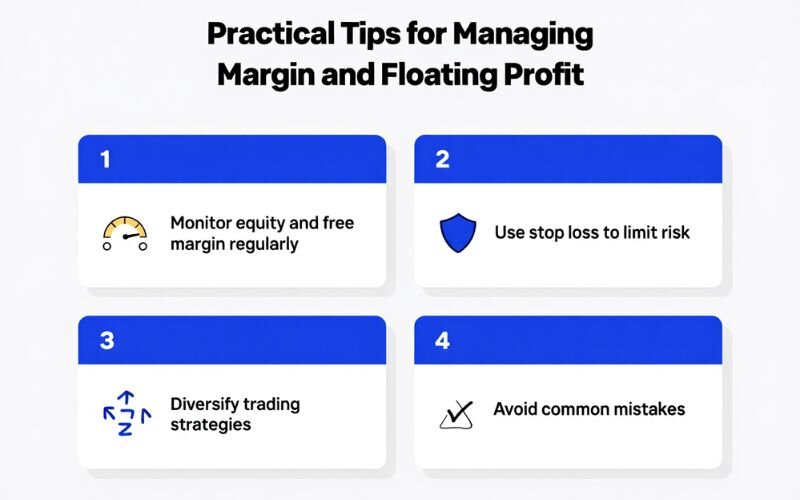
This section provides actionable strategies to monitor your account, limit risks, and optimize your trading approach.
7.1. Monitor equity and free margin regularly
Think of your equity and free margin as the main dashboard in your trading cockpit. Monitoring them regularly isn't a tedious chore; it's a proactive action that tells you exactly where you stand and how much 'fuel' you have left to open new positions or withstand volatility.
For example, if your balance is $1,000, used margin is $400, and you have a $100 floating profit, your equity is $1,100, and free margin is $700. Regularly checking these figures helps you assess whether you can open new positions or need to close trades to free up margin.
Use MT4’s margin calculator or TradingView for insights. Explore our guide on Best free Forex trading tools for more resources.
7.2. Use stop loss to limit risk
A stop loss (SL) is a critical tool to protect floating profits from turning into losses. Without an SL, a market reversal can wipe out gains and reduce equity, risking a margin call.
For instance, if you’re trading XAU/USD at 2503.72 with a $384 floating profit, a sudden 32.1-pip drop could lead to a $754.35 loss. Setting an SL at a key level (e.g., 10 pips below entry) locks in profits or limits losses.
7.3. Diversify trading strategies
Relying solely on one trading strategy can expose you to higher risks, especially when managing margin. Combine strategies like trend-following and scalping to balance risk across positions.
For example, a trend-following trade on EUR/USD might hold a floating profit, while a scalping trade on USD/JPY diversifies exposure. This approach reduces the impact of a single trade’s loss on your equity and margin level. Diversification also helps maintain free margin for new opportunities.
7.4. Avoid common mistakes
Common errors can jeopardize your margin management:
- Overtrading: Opening too many positions reduces free margin, leaving little room for market swings.
- Ignoring swap fees: Overnight fees can erode floating profits, lowering equity. For example, a $200 floating profit might be offset by $50 in swap fees over a week.
- High leverage: Using excessive leverage increases used margin, risking rapid equity depletion. Stick to conservative leverage (e.g., 1:10 or 1:20) and keep used margin below 20% of equity. For more tips, download our free margin management checklist.
8. Common questions about margin and floating profit
When exploring whether margin is still used when in floating profit, traders often have related questions about how these concepts interact. This section addresses frequently asked questions to clarify doubts and provide actionable insights, helping you navigate margin and floating profit dynamics with confidence.
8.1. Does floating profit reduce margin requirements?
No, floating profit does not reduce required margin or used margin. The used margin, which is the collateral locked to maintain open positions, remains fixed based on the position’s notional value and the broker’s margin requirement.
For example, a 1 mini lot USD/JPY trade with a 4% margin requirement locks $400, regardless of a $100 floating profit. However, floating profit increases your equity, which boosts free margin (Free Margin = Equity - Used Margin), allowing you to open new trades if sufficient. See our guide on What is free margin in Forex? for details.
8.2. Can I use floating profit to open new trades?
Yes, you can use the increased free margin from a floating profit to open new trades, provided your free margin is sufficient.
For instance, with a $1,000 account balance, $400 used margin, and a $200 floating profit, your equity is $1,200, and free margin is $800 ($1,200 - $400).
This $800 can support additional positions. However, be cautious, as market reversals can turn profits into losses, reducing free margin.
8.3. What happens if floating profit becomes a loss?
If a floating profit turns into a loss, your equity decreases, reducing free margin and potentially your margin level (Margin Level = (Equity / Used Margin) x 100%).
For example, a $200 floating profit becoming a $200 loss on a $1,000 account with $400 used margin drops equity to $800 and free margin to $400, lowering the margin level to 200%.
If the margin level falls below your broker’s threshold (e.g., 100%), you risk a margin call or stop out. Monitoring trades is key to avoiding this.
8.4. How do swap fees affect floating profit?
Swap fees (overnight financing charges) can reduce your floating profit by decreasing equity. For example, a $200 floating profit on a 3-lot EUR/USD trade might be offset by $50 in swap fees over a week, lowering equity and free margin.
Read more:
- What is a pennant pattern in Forex? Guide to this key chart pattern
- What is stop limit order? The risk management secret and trading mastery tip from experts
- Floating currency exchange rate explained for Forex implications
9. Conclusion
So, the final answer to the question, "is margin still used when in floating profit?" is a definitive "Yes." To ensure these crucial concepts stick, let's recap the key takeaways:
- Margin is always locked: Your initial margin is held as collateral until the trade is closed, regardless of profit or loss.
- Floating profit boosts equity: Unrealized gains increase your account's real-time value (Equity).
- Equity increases free margin: This is the key. A boosted equity directly increases your Free Margin, giving you more capital to open new trades or a larger safety buffer.
- Always manage your risk: Floating profits are temporary until realized. Always use tools like a stop-loss to protect your gains.
Understanding this dynamic is what separates a reactive trader from a proactive capital manager. To continue building on this foundational knowledge, explore more in-depth guides in our Forex Basics blog category. Let's take your trading knowledge to the next level with H2T Finance today!
